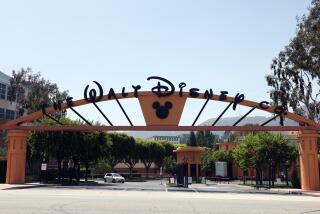The Dark Side of Disney
- Share via
The story line playing out in a Delaware courtroom could be a television hit, a tell-all about what the men of Wisteria Lane do each day after kissing their desperate housewives goodbye. The plot would revolve around two powerful executives who make the fatal mistake of letting friendship cloud their professional judgment. Both know that no single executive suite could house their combined egos, yet one agrees to work for the other. Within months, the relationship sours. The twist in this plot is that the more powerful executive can’t afford to paint the now-despised junior partner as an outright villain because there’s $200 million riding in the balance.
That’s the amount of severance pay (and interest) that disgruntled Walt Disney Co. shareholders are demanding to be repaid in a long, complicated lawsuit prompted by Michael Ovitz’s 1996 departure just 15 months after Chief Executive Michael Eisner hired him as president. The serious part of the case is that it could redefine shareholders’ ability to make corporate board members accountable for careless decisions, including rubber-stamping the bad ideas of top executives.
OK, enough of that seriousness for now.
In the real world, what rivets readers and viewers is the dark side of Disney: the dish, the character assassination, the spin that puts Karl Rove to shame. Eisner walked a tightrope during testimony as he scrambled to defend both his hiring of Ovitz and the controversial decision just months later to let Ovitz walk away with what plaintiffs allege was a $140-million severance package, paid by shareholders. Eisner described Ovitz as morphing from the hardest-working man in show biz to a walking disaster area. He testified about a failed attempt to engineer a baseball-like trade that would have sent Ovitz to a competitor. Yet Eisner ultimately had to eat his own harshest words. He dismissed as hyperbole his own lengthy memo chronicling Ovitz’s failings and said his descriptions of Ovitz as a psychopath and liar were just overstatements.
Ovitz used the witness stand to try to resurrect his reputation, arguing that longtime friend Eisner had frustrated him at every turn. And former Disney board members Roy E. Disney and Stanley P. Gold set aside their considerable differences with Eisner long enough to agree that Ovitz deserved the severance package.
Why would Disney and Gold do this? Because if they didn’t agree now with Eisner, it would mean they had not been paying attention to running the company.
Decades ago, Orson Welles wrote of Hollywood that “there must always be a strong element of the absurd in the operation of a dream factory.” The absurd is evident in the gossipy exaggeration that has been the hallmark of testimony in the Disney trial. The good news is that this trial may spare future shareholders from corporate boards that treat $140 million as pocket change.
More to Read
The biggest entertainment stories
Get our big stories about Hollywood, film, television, music, arts, culture and more right in your inbox as soon as they publish.
You may occasionally receive promotional content from the Los Angeles Times.










